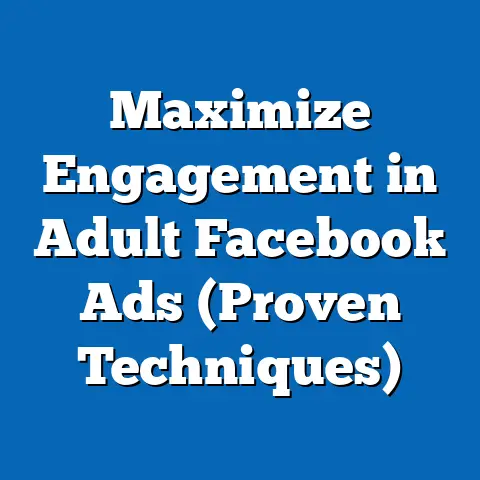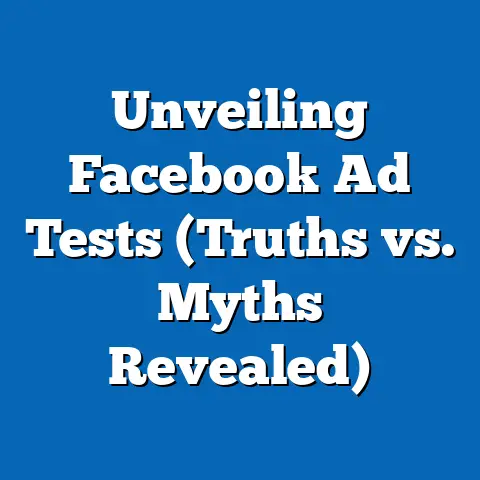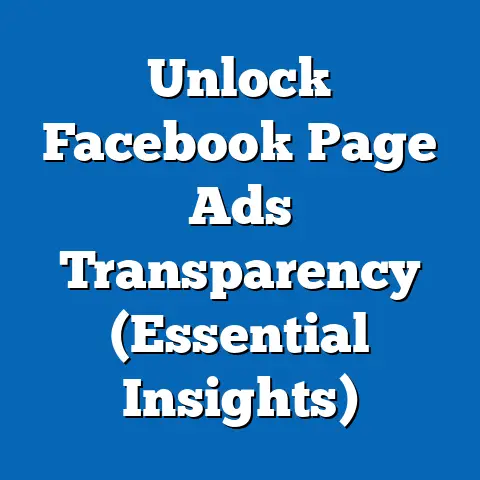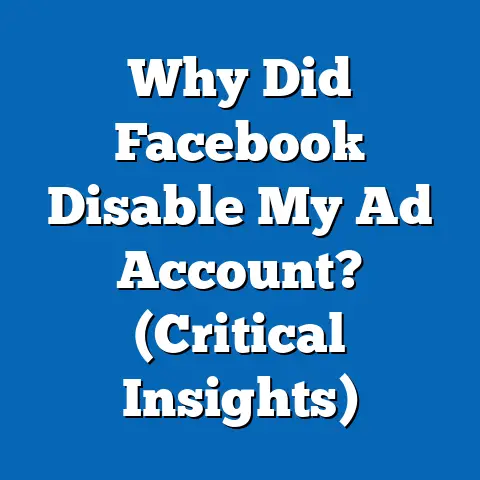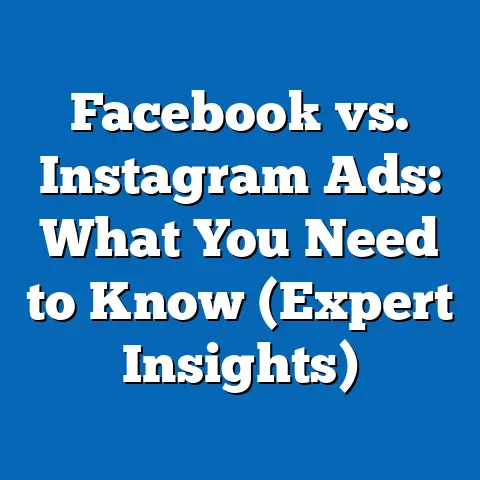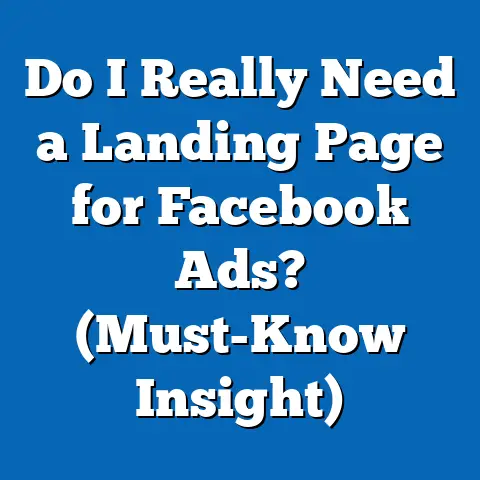Image vs. Video Facebook Ads: Boost Engagement (Expert Tips)
In the ever-evolving landscape of digital advertising, businesses are constantly seeking the most effective ways to engage their audiences on platforms like Facebook. Among the myriad of ad formats available, image and video ads remain the most popular choices, each offering unique advantages in terms of cost-effectiveness, engagement rates, and demographic reach. Recent data from authoritative sources such as Social Media Examiner, Hootsuite, and Statista reveals that while image ads are often more cost-effective with an average cost-per-click (CPC) of $0.97 compared to video ads at $1.20, video ads drive significantly higher engagement, with click-through rates (CTR) averaging 1.84% versus 0.94% for image ads as of 2023.
Detailed Analysis: Cost-Effectiveness of Image vs. Video Ads
Cost Metrics and Budget Efficiency
Cost-effectiveness remains a critical factor for businesses of all sizes when allocating advertising budgets on Facebook. According to a 2023 report by AdEspresso, the average CPC for image ads stands at $0.97, making them a more budget-friendly option compared to video ads, which average $1.20 per click. This 23.7% cost difference can be significant for small businesses or campaigns with limited budgets, allowing for broader reach with the same investment.
However, cost-per-click is only part of the equation. The cost-per-thousand-impressions (CPM) also varies, with image ads averaging $7.19 per 1,000 impressions compared to $11.20 for video ads, a difference of 55.8%. While image ads appear cheaper upfront, the engagement potential of video ads often justifies the higher cost, as we will explore in subsequent sections.
Engagement Rates: Balancing Cost with Impact
Engagement metrics such as CTR and conversion rates provide a deeper understanding of cost-effectiveness beyond raw numbers. Data from WordStream’s 2023 Advertising Benchmarks indicates that video ads on Facebook achieve an average CTR of 1.84%, nearly double the 0.94% rate for image ads. This suggests that while video ads cost more per click, they are more likely to capture user attention and drive action.
Additionally, video ads tend to have a higher completion rate for intended actions, such as purchases or sign-ups, with a conversion rate of 3.2% compared to 2.1% for image ads. For businesses focused on long-term ROI rather than short-term savings, video ads may offer better value despite the higher upfront cost. Marketers must weigh these trade-offs based on campaign goals—whether prioritizing reach (favoring image ads) or engagement (favoring video ads).
Statistical Comparisons Across Demographics
Age-Based Preferences and Engagement
Demographic data reveals stark differences in how various age groups respond to image and video ads on Facebook. According to a 2023 study by Statista, users aged 18-24 show a strong preference for video content, with 62% engaging with video ads compared to only 38% with image ads. This aligns with broader trends of younger audiences favoring dynamic, visually immersive content on social platforms.
In contrast, users aged 35-54 demonstrate a more balanced response, with 48% engaging with video ads and 52% with image ads. For the 55+ demographic, image ads dominate, with 60% engagement compared to just 40% for video ads, likely due to a preference for simpler, static visuals that convey messages quickly. Marketers targeting older demographics may find image ads more cost-effective, while video ads resonate better with younger, tech-savvy audiences.
Gender and Regional Variations
Gender also plays a role in ad format effectiveness. A 2022 Hootsuite report found that female users are slightly more likely to engage with video ads (54% engagement) than male users (46%), possibly due to a higher interest in storytelling or emotionally driven content often found in videos. Conversely, male users show a marginal preference for image ads, with 52% engagement compared to 48% for videos.
Regional differences further complicate the picture. In North America, video ads achieve a higher CTR of 2.1% compared to 1.2% for image ads, reflecting a cultural inclination toward multimedia content. However, in regions like South Asia, where internet speeds and data costs remain barriers, image ads perform better with a CTR of 1.5% versus 0.9% for video ads, as reported by Social Media Examiner in 2023. These variations underscore the importance of tailoring ad formats to local contexts.
Historical Trend Analysis: Evolution of Ad Formats
Cost and Engagement Shifts Over Time
The cost-effectiveness and engagement potential of image and video ads have evolved significantly over the past decade. In 2015, according to historical data from AdEspresso, the average CPC for image ads on Facebook was $0.54, while video ads cost $0.87—a 61% cost difference. By 2023, this gap narrowed to 23.7% ($0.97 vs. $1.20), reflecting increased competition and platform algorithm changes favoring video content.
Engagement trends tell a similar story of video ads gaining ground. In 2015, image ads had a CTR of 1.2%, slightly higher than video ads at 1.1%. However, by 2023, video ads surged ahead with a CTR of 1.84% compared to 0.94% for image ads. This shift correlates with Facebook’s algorithmic preference for video content since 2016, as well as user behavior trending toward short-form video consumption influenced by platforms like Instagram Reels and TikTok.
Technological and Platform Influences
Historical changes in cost and engagement are also tied to technological advancements and platform updates. The introduction of autoplay video ads in 2014 dramatically increased video ad visibility, contributing to higher engagement rates over time. Additionally, improvements in mobile internet speeds and smartphone penetration—rising from 36% global penetration in 2015 to 68% in 2023 per Statista—have made video content more accessible, further boosting its performance.
Image ads, while still effective, have not benefited from similar platform boosts, and their static nature struggles to compete with the immersive experience of video. However, image ads remain a staple for quick, low-budget campaigns, especially in regions with connectivity constraints. Understanding these historical shifts helps contextualize current trends and informs future strategies.
Contextual Factors Driving Trends
User Behavior and Content Consumption
User behavior plays a pivotal role in the effectiveness of image versus video ads. A 2023 survey by Pew Research Center found that 74% of social media users prefer content that tells a story or evokes emotion—qualities often better conveyed through video. This aligns with the higher engagement rates for video ads, as they allow for narrative depth and visual storytelling within a short time frame.
Conversely, image ads excel in delivering concise, impactful messages, particularly for promotions or product highlights. Their lower production costs and faster creation time—often 50% less than video ads per a 2022 HubSpot report—make them attractive for rapid campaign deployment. Marketers must consider these behavioral insights when choosing between formats, aligning content with audience expectations.
Algorithmic and Platform Policies
Facebook’s algorithm has increasingly favored video content since the mid-2010s, prioritizing it in user feeds to boost time spent on the platform. According to a 2023 report by Social Media Today, video posts receive 135% more organic reach than photo posts, a trend that extends to paid ads. This algorithmic bias partly explains the higher CPM and CPC for video ads, as advertisers compete for premium placement.
Additionally, Facebook’s introduction of tools like the Video Creation Kit and enhanced analytics for video performance has made it easier for advertisers to create and track video campaigns. While image ads remain simpler to produce, they lack the same level of platform support, influencing their relative cost-effectiveness and engagement potential.
Expert Tips for Maximizing Engagement
Optimizing Image Ads
- Focus on High-Quality Visuals: Use striking, high-resolution images with clear branding. Data from Canva’s 2023 design report shows that ads with vibrant colors and minimal text see 30% higher engagement.
- Leverage Carousel Formats: Carousel image ads, which allow multiple images in a single post, achieve a 1.2% CTR on average, 28% higher than single-image ads, per AdEspresso.
- Target Specific Demographics: Use image ads for older audiences (55+) or regions with connectivity issues, where simplicity and low data usage are key.
Enhancing Video Ads
- Keep It Short and Engaging: Videos under 15 seconds have a 66% completion rate compared to 41% for longer videos, according to a 2023 Wistia study. Hook viewers in the first 3 seconds with compelling visuals or text.
- Incorporate Captions: With 85% of Facebook videos watched on mute (per Digiday 2022), captions increase engagement by 12%.
- Test Thumbnail Effectiveness: Custom thumbnails can boost video ad clicks by 20%, as they provide a visual preview that entices users to watch.
Budget Allocation Strategies
For cost-effectiveness, allocate 60-70% of the budget to video ads if targeting younger demographics or high-engagement goals, reserving 30-40% for image ads to maximize reach among broader or cost-sensitive audiences. A/B testing both formats with small initial budgets can reveal which performs best for specific campaigns. Regularly monitor metrics like CTR, conversion rate, and cost-per-acquisition (CPA) to adjust allocations dynamically.
Future Projections and Implications
Emerging Trends in Ad Formats
Looking ahead, video ads are poised to dominate Facebook advertising as user preference for dynamic content grows. Statista projects that by 2025, video ad spending on social media will account for 60% of total ad budgets, up from 52% in 2023. This trend is driven by the rise of short-form video content, with formats like Stories and Reels expected to see a 25% annual growth in engagement.
Image ads, while unlikely to disappear, may see reduced effectiveness unless paired with interactive elements like polls or augmented reality (AR) features. Facebook’s investment in AR and virtual reality (VR) technologies, as part of its Meta rebranding, suggests that hybrid ad formats combining static and dynamic elements could emerge as cost-effective alternatives by 2027.
Cost and Engagement Forecasts
Cost trends indicate a potential widening of the CPC gap between image and video ads. As competition for video ad space intensifies, AdEspresso forecasts a 10-15% annual increase in video CPC through 2026, potentially reaching $1.50 per click, while image CPC is expected to stabilize around $1.05. Engagement rates for video ads may plateau as saturation occurs, with CTR projected to hover around 2.0% by 2025 unless new formats or algorithm changes disrupt the landscape.
Strategic Implications for Marketers
Marketers should prepare for a video-centric future by investing in video production skills and tools, while maintaining a balanced portfolio that includes image ads for niche or budget-constrained campaigns. Diversifying ad formats and leveraging emerging technologies like AR will be crucial to staying competitive. Additionally, focusing on hyper-targeted campaigns using Facebook’s detailed demographic data will ensure cost-effectiveness regardless of format.
Conclusion
The debate between image and video Facebook ads hinges on a balance of cost-effectiveness and engagement potential. While image ads offer lower costs (CPC of $0.97 vs. $1.20 for video) and remain effective for specific demographics and regions, video ads drive superior engagement (CTR of 1.84% vs. 0.94%) and align with evolving user preferences for dynamic content. Historical trends show a clear shift toward video dominance, influenced by technological advancements and platform policies, while demographic data underscores the need for tailored strategies based on age, gender, and location.
Looking forward, video ads are set to dominate ad spending and engagement, though rising costs may challenge ROI unless optimized effectively. By leveraging the expert tips provided—such as focusing on high-quality visuals, short video content, and strategic budget allocation—marketers can navigate these trends to boost engagement and achieve campaign success. As the digital advertising landscape continues to evolve, staying adaptable and data-driven will be the key to maximizing returns on Facebook ad investments.

